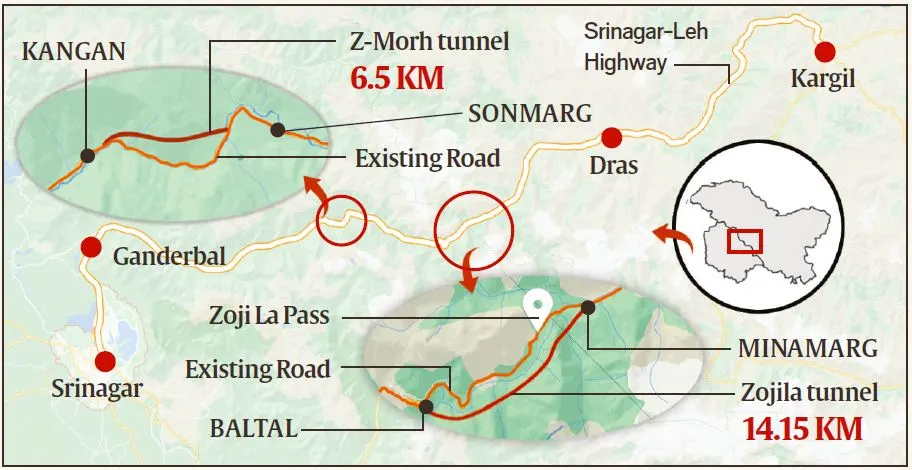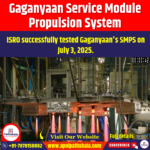GS Paper – III: Security Challenges & their Management in Border Areas, Growth & Development, Infrastructure |
Why in News?
Prime Minister Modi inaugurated the Z-Morh tunnel in Jammu and Kashmir on January 13, 2025. This significant infrastructure project aims to provide year-round connectivity to the scenic hill station of Sonamarg. The tunnel is expected to enhance the movement of people, goods and local economies.
Introduction of Z-Morh Tunnel
The Z-Morh Tunnel is a significant infrastructure development located in the Gagangeer, Ganderbal district of Jammu and Kashmir.
- This is a 6.5 km long tunnel.
- This is a 2-lane road tunnel which connects Gagangeer and Sonamarg.
- The tunnel gets its name from the Z-shaped curve of the road that it bypasses, with “Z-Morh” meaning “Z-turn” in English.
- The tunnel now provides all-weather connectivity to Sonamarg, a popular tourist destination.
- The journey through the tunnel takes just 15 minutes, compared to the several hours spent navigating the previous zigzag mountain road.
- The New Austrian Tunneling Method was employed for the construction of the Z-Morh Tunnel.
New Austrian Tunneling Method
|
Features of the Z-Morh Tunnel
- Height: The Z-Morh Tunnel is positioned at an impressive elevation of 8,652 feet above sea level.
- Cost: The total cost of constructing the Z-Morh Tunnel is estimated at ₹2,680 Crore.
- Main Tunnel: The main passage of the Z-Morh Tunnel stretches 6.5 km in length and is 10 meters wide. The tunnel significantly reduces travel time.
- Parallel Escape Tunnel: The tunnel system includes a 6.426 km-long parallel escape tunnel, with a width of 7.5 meters. This escape tunnel is designed to serve in emergencies, such as a tunnel collapse or accidents.
- Ventilation Tunnel: A dedicated 0.6 km-long ventilation tunnel with a width of 8.3 meters plays a crucial role in maintaining the air quality inside the main tunnel.
- Approach Roads: The Z-Morh Tunnel is connected to the NH-1 highway through 6.05 km of approach roads, which provide smooth access to the tunnel entrances. These roads ensure seamless connectivity from the highway to the tunnel.
- Vehicle Flow Capacity: The Z-Morh Tunnel is designed to accommodate a flow of 1,000 vehicles per hour. The tunnel is built to support vehicles traveling at an approved maximum speed of 80 km per hour.
- Western Portal: The western entrance of the Z-Morh Tunnel, located towards Srinagar, is situated in the village of Rezan, just after Gagangeer. This portal marks the starting point for vehicles entering the tunnel from the Srinagar side.
- Eastern Portal: The eastern entrance, leading towards Sonamarg, is positioned in the village of Shetkari. This portal provides access to the tunnel for travelers heading in the direction of Sonamarg and connects them to the surrounding roads and infrastructure.
Commencement and Development of Z-Morh Tunnel Project:
- The Z-Morh Tunnel project was initially conceived by the Border Roads Organisation (BRO) in 2012. The project was originally awarded to Tunnelway Ltd. under a Public-Private Partnership (PPP) model, specifically the DFBOT (Design, Build, Finance, Operate, and Transfer) mode.
- By July 2018, work on the project was halted due to financial issues. The NHIDCL (National Highways and Infrastructure Development Corporation Limited) took over the project.
- In August 2019, Apco Infratech emerged and was tasked with executing the project’s EPC (Turnkey) work, with the Amberg Group appointed as the tunnel designer.
- Although the project was initially scheduled for completion by August 2023, it faced several delays. The construction was impacted by various challenges.
- A soft opening of the tunnel took place in February 2024, but the official inauguration was postponed due to the Model Code of Conduct for the Jammu and Kashmir Assembly elections. The tunnel was ultimately opened to the public in January 2025.
Need for Z-Morh Tunnel in Jammu and Kashmir :
- Harsh Weather Conditions: The stretch of road where the Z-Morh Tunnel is being constructed lies at an altitude of over 8,500 feet. This high-altitude terrain is highly susceptible to extreme weather conditions, including heavy snowfall and avalanches during the winter months.
- Seasonal Road Closures: Due to the frequent snow avalanches and snow accumulation, the road leading to Sonamarg remains closed for most of the winter. This seasonal closure severely disrupts connectivity, making it difficult for both locals and tourists to access Sonamarg and the surrounding areas.
Benefits of Z-Morh Tunnel:
- Reduction in Travel Distance: The Z-Morh Tunnel will significantly reduce the travel distance between Gagangir and Sonamarg, cutting it from 12 km to just 6.5 km. This reduction in distance will save valuable time for travelers. Additionally, there will be no toll tax collected for using the tunnel.
- Improved Traffic Management: The tunnel is equipped with an Intelligent Traffic Management System (ITMS) that will efficiently regulate the flow of traffic. This system will help in managing congestion, especially during peak tourist seasons.
- Boost to Tourism and Regional Development: The completion of the Z-Morh Tunnel will encourage more tourism, making the region more accessible. In Sonamarg, a popular tourist destination, the tunnel will promote the development of tourism-related activities such as white-water rafting on the Sindh River and visits to attractions like the Thajiwas Glacier. This will not only benefit local businesses but also contribute to the overall social and economic development of the entire region.
Strategic Importance of the Z-Morh Tunnel for India’s Defense:
- Enhancing Strategic Connectivity: The Z-Morh Tunnel plays a vital role in enhancing India’s strategic connectivity. The tunnel ensures uninterrupted travel across key areas like Srinagar, Drass, Kargil, and Leh, which are critical for Indian defense purposes.
- Part of the Zojila Tunnel Project: The Z-Morh Tunnel is an essential component of the Zojila Tunnel Project, designed to keep the Srinagar-Leh route operational throughout the year. This project not only ensures seamless transportation but also strengthens the border infrastructure near regions like Siachen Glacier, Turtuk, and Eastern Ladakh, where India’s defense forces are deployed, providing logistical and strategic advantages.
- Boost to Military Logistics and Cost Efficiency: With aircraft previously responsible for moving troops and supplies to these frontier areas, the Z-Morh Tunnel will significantly reduce reliance on air transport. This will not only cut costs but also extend the lifespan of aircraft by reducing their frequent use for logistical purposes. The tunnel’s construction ensures that military personnel and supplies can now be transported by road.
UPSC PYQ (Previous Year Question)
|
Explore our Books: https://apnipathshala.com/product-category/books/
Explore Our test Series: https://tests.apnipathshala.com/










